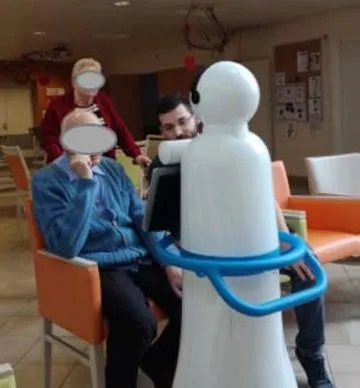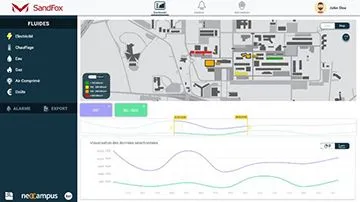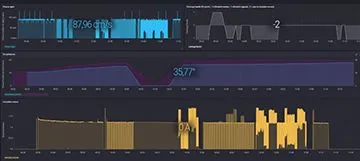
Technological change impacts all of Berger-Levrault’s business, which researches, tests, develops and deploys new solutions for its customers, based on artificial intelligence technology.
With the proliferation of data and increasing computing power, the phenomenon of digital transformation has been speeding up in recent years and has had an impact on all Berger-Levrault’s business.
We use an artificial intelligence approach to improve product performance and support our customers in adapting their businesses. Our ambition is to make personal and professional life simpler and faster, and to improve control and predictive maintenance processes.
Artificial intelligence covers a whole range of different notions that Berger-Levrault uses based on heuristic computing, that is, according to a “problem-solving method not based on a formal model, which does not necessarily lead to a solution.” The artificial intelligence techniques we use, which are both computational and combinatorial, allow us to design reliable business products for presenting and indexing information, acquiring and structuring knowledge, assessing situations and planning actions.
Since 2009, the Berger-Levrault research and innovation team has harnessed artificial intelligence and placed it at the heart of its work. No less than eight projects, in partnership with laboratories and universities in France, Spain and Morocco, are currently underway.
To design more suitable software for our purposes and to analyze how our clients use our tools and interfaces, we rely on artificial intelligence algorithms and more particularly on multi-agent systems (MAS). Through these methods, we hope to be able to recreate our users’ navigation paths in our interfaces and thus understand the uses of our tools in the field. This is an essential step to improving our solutions.
Today, the ageing of the population and increasing life expectancy are leading to an ever-growing number of people in a state of incapacity and fragility. Because of the lack of availability in specialized institutions, one alternative that has emerged is home-based care (HBC). The management of these structures and more precisely scheduling the people involved is very complicated and often manual. A multitude of constraints must be taken into account when planning interventions. The production of a manual schedule is a real challenge! To meet this need, we are exploring the creation of a planning generation tool that can take into account as many constraints and criteria as possible relating to the HBC structure.
Two types of artificial intelligence technologies are being studied:

Illustration of how the optimization algorithm works
Berger-Levrault and the Université Technologique de Troyes have been working for two years on the acceptability and possible interactions of a non-humanoid social mobile robot to support professional care practices and the relationship of dependent persons with institutions. Our sociological research program clearly has a very technological context.
Starting with usage situations, the goal is to study the uses of communicating robots by observing and then analyzing sequences of actions that promote co-participation and collaboration with the robot.
How can robotic data be used ethically? Indeed, technologies are not neutral. In addition, artificial intelligence can embed artificial moral agents. How can we consider a new way of life in situations of dependency, by using robotic machines that are socially acceptable?

Example of a prototype of the mobile social robot
Energy efficiency is defined as lower energy consumption for the same service. It has made significant progress through technology, price increases and increased awareness of waste. Energy efficiency is the primary potential source for additional domestic energy by 2020 and will be – according to the will of stakeholders (including public authorities and society as a whole) – a key market in the future and a creative innovation sector. In this context, it is necessary to implement the tools that will enable us all to capture, understand and control our energy expenditures. In this dynamic Berger-Levrault is leading a series of research projects on sustainable development. For example, we are developing a prototype dashboard to analyze data from different sensors for temperature, electricity and gas consumption, heating, water flow, etc.
For this project, we identified that the reliability of the sensors and the data they produce is a recurring problem. To solve this problem we have launched two initiatives implementing artificial intelligence techniques:

Example of an interface used for the neOCampus project
New technologies of the industrial Internet of Things, massive data processing and intelligent systems are now commonly used and increasingly efficient. In our equipment management markets, they are at the heart of the industry of the future (Plant 4.0), intelligent buildings and the smart city!
In this digital revolution, the expectations of technical services and asset managers can be high and the gains real. In this context, we are conducting research on automatic learning from data to build a multi-channel software platform capable of real-time data analysis from communicating sensors, digital mock-ups and management systems. Thus, the technical services will be able to improve the operation of the equipment (configuration of the equipment, predictive maintenance, energy efficiency, etc.) thanks to statistical evaluation and the generation of predictive models.
To do this, we are looking to build autonomous software agents capable of learning from observations to automatically model the behavior of equipment in their environments. For this project, we are collaborating with our industrial client ALSTEF Automation, a manufacturer of handling and conveying systems (such as airport baggage sorting systems).

Hypervision of sensor data from a baggage conveyor belt
Have you ever had trouble finding the right keywords to get the right result in a search engine? Have you ever had to search for information from a large volume of documents? Imagine that you could delegate tasks to an artificial intelligence personal assistant.
This is the challenge of research work recently launched in the Berger-Levrault research laboratory. The objective is to identify and make the best use of natural language processing techniques be able to analyze and query large volumes of text and unstructured documents.
In this context, Berger-Levrault has just signed a partnership agreement with the Universidad Oberta de Catalunya in Spain. The objective will be to facilitate the construction of natural language assistants, to automatically analyze text corpuses and to build generic assistants that can be tailored to the requirements, available services, data and context of our different clients.
Our cities, houses, factories and offices are filled with objects, equipment, plants, vehicles, and much more. For a local authority, maintaining, locating and inventorying all the property at its disposal can be an arduous, difficult and extremely costly task.
Computer-Aided Management and Maintenance (CAMM) software is a solution to support and facilitate these management tasks. Solutions provided by Berger-Levrault such as ATAL II or CARL Source are answers to this problem. Nevertheless, planning interventions requires knowing the equipment to be maintained and where it is located. Managers often rely on manual accounting work that is tedious and difficult.
In this area, the Berger-Levrault research team is committed to studying and developing automatic object recognition systems based on artificial intelligence techniques. Two approaches are being tested:
Recognition using satellite images or low-altitude images
Project 1: Location and cadastral management
Project 2: Location of street furniture using aerial data
The recognition of urban objects on aerial images is particularly difficult due to their small size on the images and their variable shape and appearance. Given these characteristics, urban objects are difficult to detect and conventional detection approaches do not offer satisfactory performance. For these reasons, specific recognition methods had to be developed.*
Recognition based on images and/or 3D ground scanning
Project 3: Locating street furniture using 3D data
Project 4: Inventorying office furniture from a mobile device
Another method for mapping and analyzing urban objects is to inventory them from images captured on the ground. We are experimenting with a new method based on the use of LiDAR cameras and sensors. The challenge is a system’s ability to dynamically recognize objects from flat images and 3D acquisition in the form of scatterplots.

Project 2: Example of multi-source aerial images, with a grayscale image of the digital surface model on the left, and the corresponding multispectral image on the right.
Improving the sanitation of rainwater and wastewater is a challenge for public health, environmental protection and protecting water resources from pollution. Unfortunately, sanitation cannot be improved with our current methods. The maps and geographical data of our networks are still largely analog, which makes it difficult to use and update them. In addition, in public databases, the attributes associated with the various objects in the network are often incomplete.
Therefore, Berger-Levrault has chosen to focus on the mapping aspects of urban sanitation networks by tackling the many problems associated with them. First of all, we used artificial intelligence technologies to automatically detect sewer plates on aerial images. These plates constitute the nodes of the water network which will then be crossed with other automatically collected textual information to determine slopes, geometry, materials, structures, etc. Obtaining and integrating this information will make it possible to reconstruct a map of a “probable” underground network, simulate hydraulic flows under the city and thus facilitate stormwater and wastewater management.

Illustration of sewer plate detection by aerial view